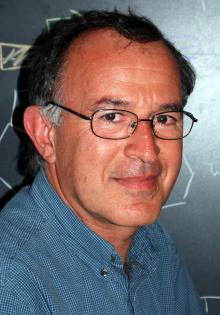

Two UC Santa Barbara faculty members –– Michael Gazzaniga, professor in the Department of Psychological and Brain Sciences, and director of the Sage Center for the Study of the Mind; and Boris Shraiman, a permanent member of the Kavli Institute for Theoretical Physics, and professor in the Department of Physics –– have been elected to the National Academy of Sciences (NAS).
Gazzaniga and Shraiman were among 72 new members from the U.S., and 18 foreign associates from 15 countries, who were elected to the Academy today in recognition of their distinguished and continuing achievements in original research. The election of Gazzaniga and Shraiman brings to 35 the number of active UCSB faculty members elected to the academy.
Gazzaniga's research includes cognitive neuroscience and split-brain research. He conducts research on how the brain enables the mind. He studies special patient populations using a variety of methodologies, including visual psychophysics, brain imaging, and anatomy.
Shraiman is a theoretical physicist with a background in statistical physics. His current research interests are in morphogenesis, addressing the problem of "growth and form" in animal development; and statistical genetics, which aims to quantitatively describe evolutionary dynamics in populations.
"Our UC Santa Barbara community and I are absolutely thrilled and proud to learn of this well-deserved honor for Professors Boris Shraiman and Michael Gazzaniga," said Chancellor Henry T. Yang. "Election to the National Academy of Sciences is not only a most prestigious recognition for scientists, but also a deeply meaningful affirmation by their peers of the significance of their pioneering research and groundbreaking discoveries. I congratulate both of our distinguished colleagues, and I thank them for the inspiration they provide to our students and to us all."
Election to the NAS is considered one of the highest honors that can be accorded a U.S. scientist or engineer. Those elected today bring the total number of active members to 2113, and the number of foreign associates to 418. The new members will be inducted into the academy next April at the group's annual meeting in Washington, D.C.
"For our campus to have two members elected to the National Academy, in a class of 72 from all fields of science, is exceptional," said Michael Witherell, vice chancellor for research."Four members of the Physics Department have joined the Academy in the last five years, which is about 10 percent of all the physicists elected over that time. It really demonstrates our standing in the world of science."
Gazzaniga was awakened by an early morning phone call today from the psychology section of the NAS, notifying him of his election. He remarked that it was 50 years ago this month that he began his first experiments in split-brain research. "Those experiments served as a foundation for my life's work and we made a large contribution to neuropsychology and the field of psychology." He remarked that, over the past 20 years, new technologies in brain imaging have caused an explosion in the capacity to assess the human brain in action, allowing for many advances in his field of cognitive neuroscience.
Gazzaniga received his Ph.D. in psychobiology from the California Institute of Technology, where he worked under the guidance of Roger Sperry, with primary responsibility for initiating human split-brain research. He subsequently made remarkable advances in our understanding of functional lateralization in the brain, and how the cerebral hemispheres communicate with one another. He has published many books, which are accessible to a lay audience, such as Mind Matters and Nature's Mind. His many scholarly publications include the landmark 1995 book for MIT Press, The Cognitive Neurosciences, now in its fourth edition. It is recognized as the sourcebook for the field. He is the founder and former editor-in-chief of the Journal of Cognitive Neuroscience and was a member of the President's Council on Bioethics from 2001-2008.
Shraiman holds the Susan F. Gurley Chair in Theoretical Physics and Biology. He received his Ph.D. from Harvard and has worked on a range of physics problems from correlated electrons and superconductivity to pattern formation and turbulence. He began working on biology problems over 15 years ago, while at Bell Labs. In both morphogenesis and statistical genetics, his work focuses on the role of interactions. "In the case of morphogenesis, these are interactions between cells; in the case of population genetics, the interactions are between genetic polymorphisms," said Shraiman. "The study of ‘interactions,' both in developmental biology and in population genetics contexts, brings up unexpected but direct and useful connections with statistical physics. Discovering, exploring and exploiting these connections in order to develop new understanding of the biological problems is the main goal of my research."
Upon hearing of his election to the NAS, Shraiman said: "It's a great honor for me. I'm quite speechless. I've been really lucky in my career doing science with great colleagues and great collaborators. UCSB and KITP are fantastic places to do science."



